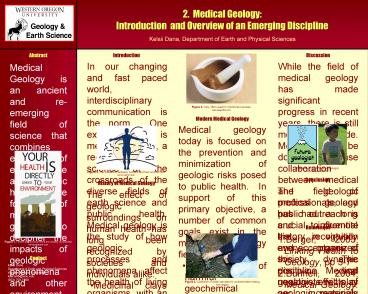Research Poster 36 x 48 - F - PowerPoint PPT Presentation
1 / 1
Title:
Research Poster 36 x 48 - F
Description:
To order poster prints visit us at www.genigraphics.com ... Introduction and Overview of an Emerging Discipline Kelsii Dana, Department of Earth and Physical Sciences – PowerPoint PPT presentation
Number of Views:50
Avg rating:3.0/5.0
Title: Research Poster 36 x 48 - F
1
2. Medical Geology Introduction and Overview
of an Emerging Discipline
Kelsii Dana, Department of Earth and Physical
Sciences
Introduction
Discussion
Abstract
While the field of medical geology has made
significant progress in recent years, there is
still more to be made. More must be done to
increase collaboration between medical and
geologic professionals, and public outreach is
crucial to promote the recognition and acceptance
of this dynamic discipline. Medical geologists
will play an increasingly larger role in the
prevention and solving of local and global health
problems (Figure 5). Education and training
opportunities should be increased, as well as
funding for beneficial and necessary research.
With adequate support and appropriate action, the
science of medical geology will continue to grow.
In our changing and fast paced world,
interdisciplinary communication is the norm. One
example of this is medical geology, a re-emerging
science at the crossroads of the diverse fields
of earth science and public health. Medical
geology is the study of how geologic processes
and phenomena affect the health of living
organisms, with an emphasis placed on the
wellbeing of humans. Geologic impacts on human
health may be traced back to both natural and
anthropogenic sources. People all over the world
are affected both negatively and positively by
their geologic surroundings (Figure 2). The study
of medical geology promises to increase the
quality of life for generations to come.
Medical Geology is an ancient and re-emerging
field of science that combines elements of earth
science and public health. The focus of medical
geology is to decipher the impacts of geologic
phenomena and other environmental factors on
human health and quality of life (Figure 1).
Significant issues in medical geology today
include toxic and deficient levels of essential
and nonessential minerals, exposure to
radioactive elements, industrial contribution to
toxic exposures, dust, and geologic events such
as volcanic eruptions. The goals of medical
geology are to identify sources of health hazards
in the geologic environment and prevent or
diminish their ill affect on humans.
Figure 3. Clay, often used for medicinal
purposes. www.keepufits.com
Modern Medical Geology
- Medical geology today is focused on the
prevention and minimization of geologic risks
posed to public health. In support of this
primary objective, a number of common goals exist
in the medical geology field - Identification of harmful geochemical anomalies,
such as toxic or deficient element levels. - Establishment of baseline contaminate levels for
continued monitoring (Figure 4). - Determination of environmental causes of health
problems and the creation of solutions. - Identification of health benefits of geologic
materials and processes. - Promotion of public awareness of geologic health
hazards and how to mitigate them. - In order to accomplish these goals a great deal
of support and recognition is needed from public
citizens and policy makers alike. The field of
medical geology has made significant progress in
this area during the past decade, particularly in
the form of organizational support - US Congress allocated funds for medical geology
research. - The International Medical Geology Association was
created in Florence, Italy in 2005. - The Geological Society of America created their
own Geology and Health Division in Fall, 2005.
Figure 5. A future medical geologist. www.littlegr
eenstar.com
Figure 2. The Interaction between humans and
their environment www3.uakron.edu
Conclusion
History of Medical Geology
The field of medical geology has had a long and
influential history in virtually every organized
society. The positive and negative effects of
geologic materials and processes are recognized
as significant to human existence, and promise to
play an influential role in the future. Medical
geology is a highly significant and influential
discipline and will continue to gain importance
in modern society.
- The effect of geologic surroundings on human
health has long been recognized by societies and
individuals alike - Medicinal clays may have been the first patented
medicine and have been used as poison antidotes
for thousands of years, as well as nutrition
sources (Figure 3). - Hippocrates (460-377 BC) described arsenic
containing minerals to be corrosive, burning of
the skin, with severe pain. - In many ancient cultures minerals were said to
have healing and preventative powers as well as
harmful properties. - Aristotle (384-322 BC) connected environmental
factors with disease rates in Greece. - Texts over 2,000 years old describe 46 different
minerals and their application to ailments, as
well as potential negative effects of minerals. - Medical geology is clearly not a new discipline,
but rather a re-emerging one. As society becomes
increasingly conscious of our environment and the
dynamic role that it plays in our lives, the
field of medical geology will gain notoriety and
momentum.
References
- Berger, 2003, Linking Health to Geology, pp 5-7
- Bunnell, 2004, Medical Geology Emerging
Discipline on the EcosystemHuman Health
Interface, Ecohealth, vol 1, pp 15-18 - Bunnell et al, Medical Geology A Globally
Emerging Discipline, Geologica Acta, vol 5, no 3,
pp 273-281 - Finkleman et al, 2005, Medical Geology The
Emergence of a New Discipline, Terrae, vol 2 pp
3-8 - Selinus, 2007, Medical GeologyAn Opportunity for
the Future, Ambio, vol 36, no 1, pp 114-116
Figure 1. Health and environment are closely
connected. nohopedesigner.com
Contact
Kelsii Dana Department of Earth and
Physical Sciences Western Oregon
University kdana06_at_wou.edu (503) 709-7398
Figure 4. Collection of water samples for
contamination testing. www.nps.gov































